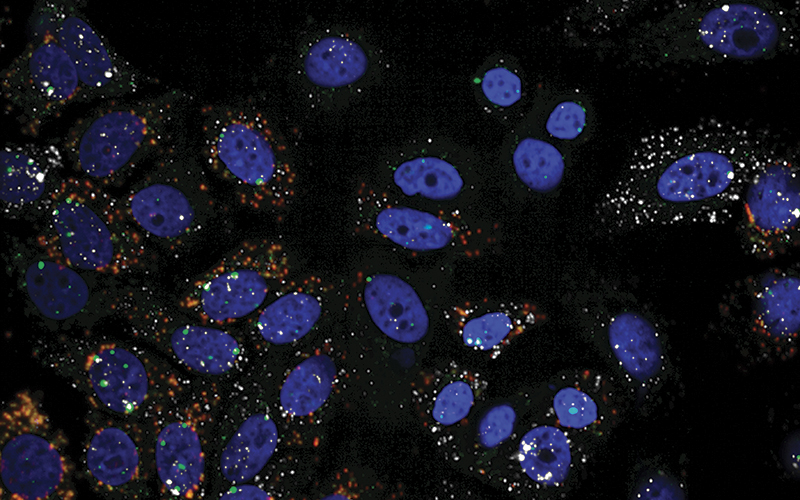Pathology Scientist Rebecca Sargeant reports on some highlights from the symposium “Applications of in situ hybridisation in research and disease”.

Currently accepted methods
The session was chaired by Dr Julia Jones from the University of Cambridge and was aimed as an introduction to in situ hybridisation (ISH) methods.
Julia began the symposium with a presentation on how the core facility has progressed to the latest generation of ISH technology – branched DNA ISH using RNAScope assays on a Leica Bond Rx. Examples of current research in the lab were discussed, including a variability study from an ongoing collaboration with Dr Will Howat.
With over 30 years of ISH experience, Dr Tony Warford from the University of Westminster described the importance of miRNA ISH applications and their relevance in research and disease examples. Tony stressed the importance of miRNA detection to show localisation in tissues and the importance of visualising these expressions in exact cell types for use alongside the “gold-standard” RT-PCR technique.
Professor Mats Nilsson from Stockholm University presented recent in situ sequencing developments, including mapping of molecularly defined cell types in mouse brains, using the brain atlas as reference for multiplexed in situ expression profiling of marker genes. Detection of targets is achieved using padlock probes for specificity and robustness and rolling circle amplification. Using these techniques, Mats has achieved specific and sensitive mutant KRAS detection in situ and point mutations in tissues, such as the dominance of mutant EGFR transcripts. These techniques are high-throughput, cost effective and allow for spatial cell typing and 3D imaging.
Evolutionary biology
Session two was chaired by Dr Romualdo Ciau-Uitz from the University of Oxford. Speakers in this session include Theresa Gross-Thebing from the University of Munster discussing methods in zebrafish models for analysing germ cell interaction guidance cues using RNAScope technology, allowing the quantification of germ cell markers and guidance que using multiplexing techniques.
Professor Jiming Jiang, from the University of Wisconsin-Madison, was the only plant biologist speaking at the conference and gave a talk about chromosome evolution revealed by comparative FISH mapping using an oligo-FISH technique conducted on several related species in the Solanaceae family.
The detection has revealed species-specific chromosomal translocations in several of the Solanum species, including potatoes and tomatoes. With molecular fingerprinting becoming a very powerful tool in evolutionary development, Dr Elia Benito Gutierrez from the University of Cambridge presented her studies in the expression profile of genes that are essential for the development of the telencephalon in vertebrates by applying ISH to serial sections of amphioxus brain tissue, identifying the most rudimentary telencephalon to date. 3D imaging was used to map genes in the brain and to identify expression, recognising something truly unique.
Emerging techniques
Professor Scott Fraser from the University of Southern California chaired the session, which began with a talk from Professor Niles Pierce from the University of Oxford. He discussed ISH chain reaction principles and showed that this is a multiplexable, quantifiable and sensitive method. Professor Jay Lee from Cold Spring Harbour Laboratory in the US talked about de novo spatial reconstruction of gene expression and cell lineage information. Jay develops technologies to quantify the influence of cell-to-cell interactions on gene expression. His team has recently implemented an in situ sequencing platform for high throughput 3D imaging. Jay applies FISSEQ techniques and performs image analysis in the hope of one day making next generation sequencing/FISH as standard as the H&E.
Asmamaw Wassie from the Massachusetts Institute of Technology presented his research with Expansion FISH (ExFISH), which uses expansion microscopy to enable super resolution imaging of RNA structure and location in thick specimens. He predicts the new technology will be used for the transcriptomic profiling of cell-types in situ and for super resolution characterisation of morphology and RNA organisation in tissues.
Asmamaw presented images of mammalian brain tissues with RNA signalling before and after the expansion technology was applied. It was clear to see that the ExFISH increased the number of RNA molecules detected after being applied to multiplex FISH serial sections. This provides an understanding of tissue function that requires scalable 3D imaging with nano particle precision.
Professor Scott Fraser presented data including multiplexed images of embryos using HCR and RNAScope technologies. Scott and his team are currently developing multimodal universal signal enhancement, which is versatile molecular gain technology for multi-plexed image-based detection of RNA species, protein and peptides.
Translational research
The final session was chaired by Dr Will Howat of AstraZeneca in the UK. Will’s presentation focused on the difficulties in preparing valid clinic-ready mRNA or miRNA ISH assays and the preparation of these assays for clinical trials within AstraZeneca. Will discussed the use of ISH and the validation processes required compared with IHC. Dr John Le Quesne from the Medical Research Council’s Toxicology Unit uses a range of ISH and molecular methods on his tumour biology research. The dysregulation of mRNA translation in the final consequence of many driving mutations in common cancers, and translational control is emerging as a new target in cancer therapy.
John’s team has developed a method of quantitative multiplex fluorescence ISH/IHC, enabling quantification of mRNA and proteins simultaneously.
His work has linked translational control to cell behaviours using in situ for potential biomarkers. He has found that translational control is related to epithelial plasticity in pulmonary adenocarcinoma.
The presentation of Boye Schnack Nielson from Bioneer in Denmark focused on microRNA and his recent work in understanding the role of miR-21 in cancer progression, with the aim to use it as a prognostic and diagnostic marker. Characterising miRNA expressing cells in complex tissues using combined ISH and IHC techniques on FFPE sections involves many methodologic considerations. Using fluorescent ISH techniques combined with IHC proved easier to characterise microRNA using LNA-based ISH techniques to demonstrate miR-21 localisation in tissues.
Rebecca Sargeant is a Pathology Scientist at AstraZeneca.
The symposium was hosted by the University of Cambridge’s Cancer Research UK Cambridge Institute and organised by the Scientific Organising Committee.




